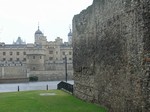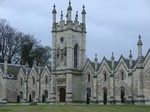|
|
ENGLISH STONE FORUM |
|
.
|
Home
> Issues > Building stone industry in Britain
1 | 2
| 3&4 | 5
| 6 | 7
| 8 | 9
| 10 | 11
|
|
|
The
Building Stone Industry in Britain: Past and Present
Graham Lott Introduction
|
| 1.
Britain's building stones: a brief history
A stone is defined by the Oxford Dictionary 'as a piece of rock of any shape usually detached from the earth's crust ............usable in building or road making or as a missile'. In Britain we are fortunate to have one of the most diverse assemblages of natural stones in the world which includes igneous, metamorphic and sedimentary rock types. The oldest rocks in Britain (the Lewisian of Scotland) have been dated as 2.7 billion years old. Our youngest lithified rocks, which have been used for building purposes are of Tertiary age (c. 2 million years). Throughout our history we have used our stones in a wide variety of ways, we have gathered, quarried, cut, crushed and carved them and an appreciation of their usefulness either based on their durability or on their varied colours in ornamental and decorative ways are commonly evident from earliest times. In prehistoric times hard stones provided durable primitive tools and rough shelters were built from stone slabs. |
|

Stonehenge Sarsen stone and Blue stone |
Stones
large and small were carefully arranged to define places of worship or
burial and stones have been long used to mark the site of important meeting
places.
Much of this early history of our stone industry has been forgotten or lost, which is unfortunate when its importance to our development as a nation is considered. The earliest use of stone in the UK was as primitive stone tools or weapons. Quernstones for grinding corn etc, sharpening stones (hone- or whet-stones), stone hand axes, spear and arrowheads, for example, are common artefacts in many ancient archaeological sites throughout Britain. The earliest housing often took the form of rock caves or stone built shelters. There are many examples of the use of stones to mark important places of ritual significance ranging from the megaliths of Stonehenge to numerous smaller stone circles like Castlerigg in the Lake District. In prehistoric times stone was also commonly used for prestigious burial chambers as at West Kennet and Wayland Smithy in Wiltshire. The Romans were probably the first people to bring and use sophisticated quarrying methods to obtain stone for building in Britain. Many Roman villas, towns and forts were built with stone and some used stone slates for their roofs (e.g. Wroxeter; Caerwent Fort, Margidunum). The Romans brought quarrying skills, already developed from a long experience of working stone in the rest of their empire, some of which are still used in todays' quarries. They were among the earliest builders to use ashlar or cut stone blocks for their more important structures. The Roman roads of Britain have foundations of stone with stone cobbled or paved surfaces as at Wheeldale Moor, North. Yorkshire. One of their crowning achievements as stone users must be the construction, incorporating a variety of locally quarried stones, of Hadrian' s Wall, built between AD 122-130 and marking the northern limits of their power. |

Roman Wall and Tower of London |
The
departure of the Romans was followed by a period of gradually increasing
Anglo-Saxon influence. The Anglo-Saxons used wood for much of their building
but were well aware of the usefulness of stone. With the spread of Christianity
they began to use stone more widely, particularly in their churches (e.g.
Brixworth Church; Repton Crypt). The many surviving elaborately carved
Saxon stone crosses and monuments are testament to their skill as stone
carvers (Bewcastle Cross, Carboniferous sandstone from Middle Border Group;
the Leeds cross, Carboniferous, Millstone Grit sandstone) and their appreciation
of its durability. Even the Viking invaders of the 8th century, portrayed
by many history books as unsophisticated barbarians, showed an appreciation
of stone for decoration and ornamentation and copied the Anglo-Saxon penchant
for carved stone crosses (e.g. Gosport Cross) and also produced elaborate
stone sepulchral monuments like the Brompton Hogbacks (Carbonifereous Millstone
Grit).
The Norman invasion in the 11th century brought with it a resurgence in stone building work in Britain and marked the beginning of a period during which many of our most splendid stone buildings were constructed. Their influence is evident from the incorporation of many familiar building and architectural terms from the old French into the English language e.g. mason from maçon - builder; aiseler - ashlar ; slate -esclat - to split; voussoir – wedge-shaped stone in the apex of an arch. Determined to show the restive British who was in control they began building fortifications on a large scale. At first they preferred to import the stones which they were most familiar with for these structures, such as Middle Jurassic limestone from the Boulogne and Caen quarries e.g. White Tower of London. Eventually, however, they also recognised the quality of British stones and, as their influences spread, began to exploit a wide variety of local stones for castles and other building projects e.g. Conisborough.-Permian Magnesian Limestone; Goodrich - Devonian sandstones. The spur which the Normans gave to Britain's indigenous stone industry was unprecedented. |
| As
they further consolidated their grip on the country they also commenced
the building of the cathedrals at Canterbury (Caen, Marquise and Quarr
stones (Tatton-Brown 1990), Durham (Carboniferous sandstone), Lincoln (Middle
Jurassic Lincolnshire Limestone) and Winchester (Quarr & Bath Oolite
(Tatton-Brown 199?) and monasteries such as Rievaulx (Middle Jurassic sandstones
and Upper Jurassic limestones (Senior 199?) and Tintern (Devonian sandstones
(Lott & Barclay 1998)).
This building 'boom' continued during the late 13th and early 14th centuries. Edward I in his single-minded determination to bring the remainder of his unruly subjects to heel, continued this great Norman building tradition by constructing a series of massive castles across North Wales (Aberystwyth, Harlech and Conwy - Lower Palaeozoic sandstones, Beaumaris and Caernarvon - Carboniferous limestones (Neaverson 1947). The scale of this work programme was so great and the number of masons conscripted to work in it so large (400 at Beaumaris), that it must have disrupted royal building programmes elsewhere for some considerable time. During the early 15th century many of England’s most ornate churches were built using the profits of its thriving wool trade (Long Melford and Lavenham (Lincolnshire Limestone & Flint), Suffolk; Northleach and Chipping Camden (Middle Jurassic, Cotswold Stone), Gloucestershire. Financial patronage for the building of such new parish churches evidently ensured salvation. Most ordinary people, however, still built their houses from wood harvested from the still extensive forests. Not every English King, was by any means as interested in building on such a grand scale and by the mid-16th century the focus of attention changed. In 1538 the split between the King Henry VIII and the Pope in Rome precipitated one of the 'greatest acts of vandalism' in our history. As a consequence of his break with Rome the King ordered the dissolution of all the monastic houses in Britain and the selling off (or slighting, to make them unusable) of their buildings and estates to his court favourites or to the highest bidder. This process allowed many of the growing class of wealthy 'entrepreneurs' to purchase grand houses and become part of a new aristocracy. Some of our most spectacular stone buildings, rivalling or even surpassing our surviving great cathedrals, were almost completely demolished by their new owners. Others were converted to new grand houses e.g. Woburn, Calke and Newstead. For many decades the monasteries became new 'quarries' as their stone and other building materials were robbed or nowadays 'recycled' for use elsewhere. Today abbey ruins like those at Glastonbury (Doulting Stone), Roche (Magnesian Limestone), Fountains (Middle Jurassic sandstone) Tintern and Jedburgh (Devonian sandstones (MacGregor & Eckford 1948)) allow us only a glimpse of what their largely unidentified medieval builders and masons could achieve. The right to quarry stone was still very much under the control of the Crown into the early 17th century and the large scale use of stone for building was restricted to major royal or secular projects. The future of the Portland Stone Quarries was established at this time by the rebuilding of London following the disastrous Great Fire in 1666. The repercussions of this tragedy lead to many other towns and cities enforcing the using of stone for building and roofing to prevent further such calamities in their overcrowded, timber-framed, urban centres. During the 17th century the continued rise of the prosperous yeoman (farmer) and the growth of the merchant or professional classes in the population led to the building of many more new stone 'Manor' houses e.g. Middleton Hall, Cumbria; New Hall, Elland (Millstone Grit), Yorkshire; Ightham Mote (Cretaceous, Kentish Ragstone), Kent. |
|

Aberford almshouse Magnesian limestone |
From
the early 18th to the mid-19th century the gathering pace of industrial
revolution, the growth of new industries and their associated and expanding
rural and urban populations, all needing houses and places of work, allowed
the stone quarrying industry began to expand accordingly. Ralph Allen,
perhaps our first ‘great’ entrepreneur of the stone industry, developed
and expanded the Bath Stone quarries at Combe Down which began to compete
directly with the Crown controlled Portland Quarries in the London market
by taking advantage of the fast growing canal newtork. In the dimension
stone industry access to good transportation was clearly a major advantage
for any quarry and many others took advantage of the network e.g. Anston
quarries (Permian, Magnesian Limestone) used the Chesterfield canal.
Quarrying now became a major industry in many other parts of the country, particularly, around the embryonic industrial centres of the midlands and north. In Yorkshire and Derbyshire the Carboniferous sandstones were quarried along almost every craggy outcrop. Some quarries, such as those at Bramley Fall, Elland Edge, Scotgate Head and Meanwood in Yorkshire and Stancliffe Darley Dale and Duke's Gritstone in Derbyshire and St Bees in Cumbria even began to export their stone abroad to the new 'colonies'.of the British Empire. |

Lincolnshire limestone Lincoln museum |
The
late Victorian period saw a massive expansion of industrial and urban centres
particularly in the north of England and Victorian architects selected
and used British building stones to great and colourful effect. This was
despite competition from the increasingly mechanised and developing
brick industry and other 'new' materials such as terracotta and faience,
whose glazed surfaces were considered more resistant to atmospheric pollution.
Confident and newly wealthy city councils determined that their most important
civic buildings should be built of natural stone and a grand scale (e.g.Leeds
Town Hall - Carboniferous Bramley Fall and Bolton Wood Stone; Nottingham
City Hall - Portland Stone; Manchester Town Hall, Springwell Stone; Bradford
Town Hall Carboniferous Spinkwell Stone and Sheffield Town Hall, Stoke
Hall Stone from Grindleford, Derbyshire).
The durability of stone was also appreciated for large scale engineering projects. Many reservoirs were constructed to supply water to the new urban and industrial centres and stone was commonly chosen for the facing structure (Ladybower Reservoir, Grindleford Stone, Carboniferous Millstone Grit). The great railway viaducts of Settle and Carlisle railway were built of local Carboniferous limestones. As Britain's trade overseas expanded our major seaports, which needed hard, resistant sandstones and granites for quaysides and dockyards developed extensively, for example, in London (Aberdeenshire and Cornish granites) and Liverpool (Dalbeattie granite). The stone industry did not, however, exclusively concern itself with quarrying for building stone. There were many other trades reliant on the production of stone for industrial purposes. In Northumberland, Yorkshire, Lancashire and Derbyshire the sandstones of the Carboniferous Millstone Grit were also worked for the eponymous millstones and the much larger pulp stones for the new paper mills. Both were exported all over the world at the height of the industries' development. The hardest stones were commonly used in massive blocks as beds for anchoring heavy engineering equipment in mills and factories. On a smaller, but equally important scale, the sandstone quarries provided provided grindstones for sharpening tools (essential to the growing cutlery industry in Sheffield). In the Wickersley area of Sheffield in 1858 there were at least 30 quarries producing a wide range of grindstones and sharpening stones for the cutlery industry (Hunt 1858). Smaller local trades concentrated on producing bakestones, cheese and cider presses, cisterns, paint mixing and water troughs etc also flourished. On a more sombre note, stone has always had a special place in our culture with regard to burial sites. In earliest times the durability of stone usually meant that the most important burials used stone coffins, niches cut into stone bedrock or were marked by stone monuments. As our society has developed we have held on to this notion and to many people the selection of an attractive and durable headstone is still a very important family ritual. There have been many skilled artisans over the centuries who have produced elaborately carved headstones (e.g of Swithland Slate in Leicestershire), but this type of monumental stone craft probably reached its zenith in Britain during the Victorian period when highly ornate family tombs were often constructed as a measure and celebration of the success of a businessmen. Paramount among such monuments is the Albert Memorial in Hyde Park which uses over 13 different British stone varieties. In more recent times, however, perhaps the most poignant use of stone in this form must be one order placed with the Hopton Wood Quarries (Carboniferous Limestone, Derbyshire) for 120,000 gravestones for those soldiers who fell in the 1st World War Portland Stone. Similar orders were also filled from the Bath and Portland quarries for the dead of the 2nd World War. |
| Today, new stone buildings have become something of a rarity. Instead of the load-bearing block stone the demand is now for flawless thinly slabbed stone which can be used to clad core structures of concrete and steel. These slabs have to meet increasingly tight testing specifications and need to demonstrate very different strength and durabilty parameters to traditional building stones before they can be accepted by the building industry. Some of our best known stones may not reach these exacting standards but the variety of our stone resources suggest that new British stones could be found to take their place. | |
| 1 | 2 | 3&4 | 5 | 6 | 7 | 8 | 9 | 10 | 11 | |
| . |
|